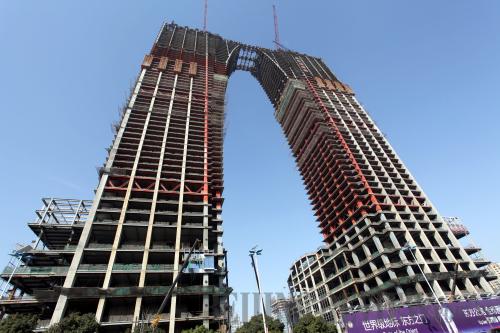|
 |
|
GROTESQUE BUILDING: Workers install curtain walls on the Gate of the Orient in Suzhou, Jiangsu Province, on March 24 (LI JUNFENG) |
Despite all the online mockery, the Gate of the Orient is not short of admirers in the architectural community, including Professor Zhou Qi at Southeast University in Nanjing, Jiangsu. "The gate-shaped building by the side of a lake symbolizes prosperity for a city. Although the design is China's answer to the Arc de Triomphe, it also reflects the aesthetic standard of harmony in traditional Chinese architecture by using soft and smooth curves over the top of the gate," Zhou told the Xinhua News Agency.
Ge Baojian, who works not far from the construction site of the Gate of the Orient, told Xinhua that people who complain that the building runs counter to Suzhou's long history are likely unfamiliar with its vigor as a modern city. "It is too early to tell whether the building will become a successful piece of innovation or a laughing stock. Only time will tell," Ge said.
Zhao Yu, Deputy Director at the Shenyang Architecture Design Institute in northeastern Liaoning Province, told the China News Service that everyone can use his or her own aesthetic preferences to judge architecture but should be mindful of the fact that cities are in constant need of new images and structures.
Public participation
Some amateur architecture critics are more concerned about how taxpayer money is being spent for publicly funded buildings.
One structure coming under attack from online critics recently is an overpass in Shenzhen, south China's Guangdong Province. Critics question the necessity of its hi-tech facilities and huge costs.
The overpass, constructed from materials commonly found in the aerospace industry and called the "spring flower" after its shape, is equipped with more than 1,000 high-quality LED screens and the latest solar panel technology, in addition to two lifts and four escalators.
But the costly screens and elevators haven't functioned for a long time and the overpass surface is frequently flooded, according to anonymous online complaints.
Local Nanshan District Government claimed to have spent 50 million yuan ($7.95 million) on the project. Unofficial estimates put the cost at about 2 billion yuan ($318 million). Whatever the figure, the local government has promised to "make improvements to the current problems," according to an online statement on August 17.
"The overpass is fancy and luxurious, but isn't practical at all," an anonymous local resident told Xinhua.
The "spring flower" was built as a landmark before Shenzhen hosted the 2011 World University Games. It was an urgently built project to improve the city's image, said the city's urban construction authority.
The Nanshan District Government attributed the overpass's huge investment to its location in a busy area where there are two major roads, office buildings and residential communities.
Previous scandals on misused public funds in China include the construction of luxurious government office buildings, expensive road lamps and "five-star" public toilets.
Zhang Jiangang, an esthetician from the Chinese Academy of Social Sciences, told the Beijing Morning Post that while local governments shouldn't be criticized for erecting buildings to highlight local culture, the public should have a say in how buildings should look.
Zhang said that public buildings should be judged not only by their physical grandness, but also their ability to fulfill their designed functions, an aspect of construction often ignored in China. He suggested that public funds should be allocated toward fulfilling a city's basic needs first, otherwise residents will naturally become skeptical.
"Sometimes the public is not dissatisfied with the buildings themselves, but with unchecked power," Zhang said. "When public funds pay for the construction of grand and lavish buildings, taxpayers often feel their own money is being wasted. If that's the case, they won't care to admire even the most beautiful designs."
Email us at: lili@bjreview.com | 